![]()
![]()
![]()
Use LEFT and RIGHT arrow keys to navigate between flashcards;
Use UP and DOWN arrow keys to flip the card;
H to show hint;
A reads text to speech;
56 Cards in this Set
- Front
- Back
|
Functions of life (6)
|
1. metabolism
2. response 3. homeostasis 4. growth 5. reproduction 6. nutrition |
|
|
Characteristics of unicellular organisms
|
1. only one cell
2. has to carry out all functions of life e.g. Amoeba: 100 micrometer |
|
|
Characteristics of multicellular organisms
|
consist of many specialised cells
|
|
|
Cell Theory
|
1. Living organisms are composed of cells
2. Cells are the smallest unit of life 3. Cells come from pre-existing cells |
|
|
Differentiation
|
Cells in multicellular organims develop in different ways and carry out different functions. This is calles differentiation.
|
|
|
3 Examples of specialised cells
|
1. Heart muscle tissue
2. Sensory neuron 3. Beta cell in the pancreatic islets |
|
|
Stem cells
|
defined as cells that have the capacity to self-renew by cell division and to differentiate
|
|
|
Where do you find stem cells in the adult body?
|
bone marrow, skin, liver
|
|
|
Example: Treatment of disease with stem cells
|
Parkinson's disease, multiple sklerosis and strokes all involve the loss of neurons or other cells in the nervous system. Although still only at the research stage, there is the potential to use stem cells to replace them
|
|
|
Example: Therapeutic use of stem cells (p. 4)
|
1. The placenta and umbilical cord is used as asource of stem cells. The collected cord blood contains many hematopoietic stem cells. These cells can divide and differentiate into any type of blood cell
2. Red blood cells are removed from the cord blood. 3. Cord blood can be used to treat children with leukemia. If suitable cord blood is available, the patient is given chemotherapy drugs that kill the bone marrow cells, including the cells causing the leukemia. 4. The selected cord blood is introduced into the patient's blood system, usually via a vein in the cheast or the arm. The hemapoietic cells establish themselves in the patient's bone marrow, where they divide repeatedly to build up a population of bone marrow cells to replace those killed by the chemotherapy drug. |
|
|
Units for size measurements
|
1 mm = 1000 micrometer
1 Micrometer = 1000 nanometer |
|
|
Magnification
|
(size of image)/(size of object)
|
|
|
size of eukaryotic cells
|
10-100 micrometer
|
|
|
size of organelles
|
2-10 micrometer
|
|
|
size of bacteria
|
1 micrometer
|
|
|
size of Viruses
|
100 nm
|
|
|
Thickness of cell membranes
|
10 nm
|
|
|
Size of molecules
|
1 nm
|
|
|
Prokaryotic cells (PC)
|
- no nucleus
- all bacteria - divide by binary Vision |
|
|
Cell wall (PC)
|
forms a protective outer layer that prevents damage from outside and also bursting if internal pressure is high
|
|
|
Plasma Membrane (PC)
|
Controls entry and exit of substances, pumping some of them in by active transport
|
|
|
cytoplasm (PC)
|
Contains enzyms that catalyse the chemical reactions of metabolism and contains DNA in a region called the nucleoid
|
|
|
Pili (PC)
|
Hair-like structure projecting from the cell wall, that ban be teatcheted in and out, when connected to another bacterial cell, they can be used to pull cells together
|
|
|
Flagella (PC)
|
Solid protein structures, with a corkscrew shape, projecting from the cell wall, which rotate and cause locomotion.
|
|
|
Ribosomes (PC)
|
Small granular structures that synthesize proteins by translation messenger RNA.
|
|
|
Nucleoid (PC)
|
Region of the cytoplasm that contains naked DNA, which is the genetic information of the cell
|
|
|
Draw a Prokaryotic cell!
|
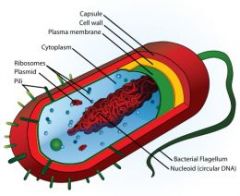
|
|
|
Draw a eukaryotic cell!
|

|
|
|
Type of genetic material in PC/EC
|
PC: a naked loop of DNA
EC: chromosomes consisting of strands of DNA associated with Protein. Four or more chromosomes are present |
|
|
Location of genetic material in PC/EC
|
PC: in the cytoplasm in a region called the nucleoid
EC: in the nucleus inside a double nuclear membrane called the nuclear envelope |
|
|
Mitochondria in PC/EC
|
PC: not present
EC: always present |
|
|
Ribosomes in PC/EC
|
PC: small sized - 70s
EC: larger sized - 80s |
|
|
Internal membranes in PC/EC
|
PC: few or none are present
EC: many internal membranes that compartmentalize the cytoplasm including ER, Golgi apparatus, lysosomes |
|
|
Cell wall in animal and plant cells?
|
AC: no cell wall, only a plasma Membrane
PC: cell wall and plasma membrane |
|
|
Chloroplasts in animal and plant cells?
|
AC: not present
PC: present in cells that photosynthesize |
|
|
Polysaccharides in animal and plant cells?
|
AC: glycogen
PC: starch |
|
|
Vacuoles in animal and plant cells?
|
AC: not usually present
PC: large fluid-filled vacuole |
|
|
Shape of animal and plant cells
|
AC: able to change shape. Usually rounded
PC: Fixed shape. Usually rather regular |
|
|
Draw a biological membrane!
|
(including phospholipids, integral Proteins, peripheral Proteins, glycoprotein, cholesterol, channelproteins)
|
|
|
Functions of membrane Proteins
|
1. hormone binding site
2. enzymes 3. electron carrier 4. channels for passive transport 5. pumps for active transport |
|
|
Diffusion
|
Diffusion is the passive transport of particles from a region of higher concentration to a region of lower concentration.
|
|
|
Osmosis
|
Osmosis is the passive movement of water molecules froms a region of lower solute to a region of higher solute concentration, across a partially permeable Membrane.
|
|
|
Endocytosis
|
1. part of the plasma membrane is pulled inwards
2. a droplet of fluid becomes enclosed when a vesicle is pinched off 3. vesicles can then move through the cytoplasm carrying their contents |
|
|
Exocytosis
|
1. Vesicles fuse with the Plasma membrane
2. the contents of the vesicle are expelled 3. the membrane then flattens out again |
|
|
Role of the plant's cell wall
|
1. maintaining the cell's shape
2. prevent the cell from bursting 3. support 4. prevent high water uptake |
|
|
Role of glycoproteins
|
1. supporting single layers of thin cells
2. cell to cell adhesion |
|
|
Draw the cell cycle!
|
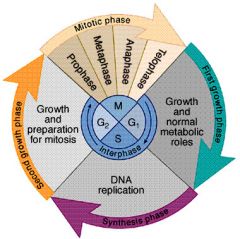
|
|
|
phases of mitosis
|
prophase, Metaphase, anaphase, telophase
|
|
|
Early prophase
|
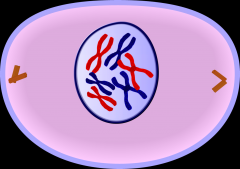
1. Spinde microtubules are growing
2. supercoiling of chromosomes |
|
|
late prophase
|
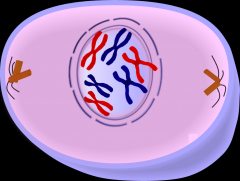
1. spindle microtubules extend from each pole to the equator
|
|
|
Metaphase
|
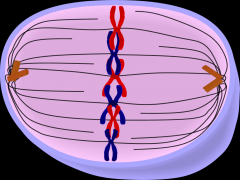
1. nuclear membrane has broken down and chromosomes have moved down to the equator
2. spindle microtubules are attached to each centromere on opposite sides |
|
|
anaphase
|

1. the centromeres have divided and the chromatids have become chromosomes
2. spindle microtubules pull the genetically identical chromosomes to opposite poles |
|
|
early telophase
|
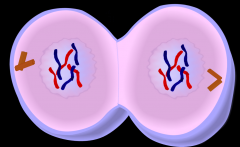
1. all chromosomes have reached the poles and nuclear membranes form around them
2. spindle microtubules break down |
|
|
late telophase
|

1. chromosomes uncoil and are no longer individually visible
2. the cell divodes (cytokinesis) to form two cells with genetically identical nuclei |
|
|
When is mitosis needed?
|
1. during growth
2. during embryonic development 3. when tissue needs to be reparier 4. o reproduce asexually |
|
|
Formation of a tumour
|
repeatedly uncontrolled divisions produce a mass of cells called tumour
|

